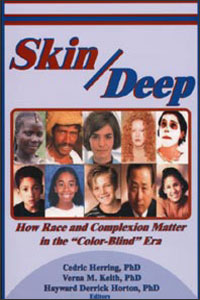The Politics of Biracialism [Issue]Posted in Articles, Barack Obama, Census/Demographics, Communications/Media Studies, History, Identity Development/Psychology, Media Archive, Social Science on 2010-02-01 18:54Z by Steven |
The Politics of Biracialism [Issue]
The Black Scholar
Journal of Black Studies and Research
Fall 2009 (2009-09-22)
Volume 39, No. 3/4
Guest Editors:
Laura Chrisman, Professor of English
University of Washington
Habiba Ibrahim, Assistant Professor of English
University of Washington
Ralina Joseph, Assistant Professor of Communications
University of Washington
Why a biracial issue, and why now? As black Americans we have mixed ancestry; one might ask what is gained by giving this obvious fact the attention of a special issue. Rather than focus on this broad history, however, we instead highlight here the situations of first-generation biracial black people. Perhaps this does not simplify matters. Foregrounding their specific experiences, identities, and concerns may stir up the anger of those who feel judged “not black enough” and the anger of those who feel betrayed and devalued by self-identifying biracial individuals. The politics of biracialism, seen this way, are individualistic, diminishing our community’s cohesion. Yet we feel that the time is right for an exploration of the topic. Biracial or multiracial studies is fast-growing and itself extremely varied in its methods, disciplines, and orientation. Acknowledging the important and interesting work that has been produced in the last two decades, we provide a forum for such work. Another factor in our choice of topic is the emergence, in 2008, of Obama as a presidential candidate. Both his blackness and his first generation biracialism have prompted new consideration, within black communities and within the U.S. population as a whole, of the operations and meanings of race, nation, family and community within the U.S.A. This gives us additional incentive to explore biracialism in the present moment. Our moment differs from the fraught late 1990s when the multiracial social movement campaigned for recognition in the 2000 Census, and was opposed by influential black voices. The present adds some confidence and optimism: to profile biracialism now, we suggest, is not to jeopardize black collectivity so much as it is to recognize and join the healthy debates that are flourishing within and beyond black studies…
- Introduction to “The Politics of Biracialism” / Laura Chrisman
- Interracial Intimacies, Barack Obama, and the Politics of Multiracialism / Kimberly McClain DaCosta
- Review Essay: Performing the Twenty-first Century Tragic Mulatto: Black, White, and Jewish: Autobioraphy of Shifting Self by Rebecca Walker / Ralina Joseph
- Toward Black and Multiracial “Kinship” After 1997, or How a Race Man Became “Cablinasian” / Habiba Ibrahim
- Poetry: “The Art of Loving” / Madeleine Clifford
- Baby janay and Naomi Pabst: Negotiating Race Mixing, Adoption, and Transnationality / Naomi Pabst
- Reframing the National Family: Race Mixing and Re-telling American History / Catherine Squires
- Race, Multiraciality, and Barack Obama: Toward a More Perfect Union? / G. Reginald Daniel
- Books Reviews
- Amalgamation Schemes: Anti-blackness and the Critique of Multiracialism by Jared Sexton / LeiLani Nishime
- Dispatches from the Color Line: The Press and Multiracial America by Catherine R. Squires / Manoucheka Celeste
- Framing the Black Panthers: The Spectacular Rise of a Black Power Icon by Jane Rhodes / Madhavi Murty
- Mixed Race Hollywood Edited by Mary C. Beltrán and Camilla Fojas / Sarita Cannon


